Homemade Sourdough Bread, Step by Step
This post may contain affiliate links. Please read my disclosure policy.
If you love fresh sourdough bread with a golden, crisp crust and a light, airy crumb, this recipe is for you. It’s one of the simplest homemade sourdough bread recipes, and one of the best, too. It requires only 25 minutes of hands-on work and no autolyse or preferment. Below you will find guidance for every step of the way. 🍞🍞🍞
⭐️⭐️⭐️⭐️⭐️ Review:
“Absolutely the best sourdough recipe EVER! I have been baking bread for years (sourdough included,) and things were many times hit or miss. Not with your recipe. You have nailed it. I thank you!” — Rosemary Patterson
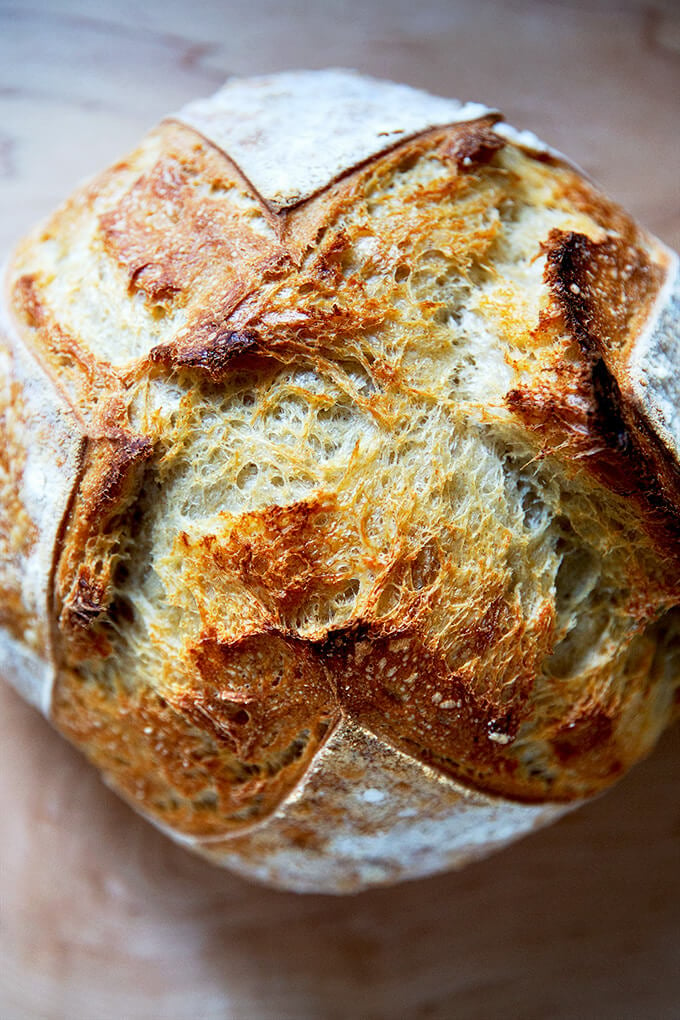
This post will show you how to make the simplest of simple sourdough breads. There is no autolyse or preferment, which means the dough itself comes together in less than five minutes.
For those intimidated by sourdough bread baking, this recipe, as well as this sourdough focaccia recipe, are the recipes I suggest making first, both for their simplicity and flavor. Another great beginner’s bread recipe to try is this overnight, refrigerator focaccia or my mother’s simple peasant bread recipe, both of which require minimal effort but yield spectacular results.
This post is divided into 13 sections:
- What is Sourdough Bread?
- What is a Sourdough Starter?
- How to Feed a Sourdough Starter
- When is My Starter Ready to Be Used?
- Equipment
- How to Make Sourdough Bread: A 5-Step Overview
- How this Sourdough Bread Recipe Differs From Others
- Simple Sourdough Bread: A Step-by-Step Guide
- #1 Sourdough Bread Baking Tip
- Troubleshooting: Where Sourdough Goes Wrong
- Sourdough Baking Resources
- Other Sourdough Bread Recipes to Make
- Sourdough Bread Baking Schedule

What is Sourdough Bread?
Sourdough bread is bread that has been leavened naturally, meaning it has been leavened by a sourdough starter as opposed to by commercial yeast or a chemical leavening agent such as baking powder or baking soda.
What is a Sourdough Starter?
A sourdough starter is a fermented mix of flour and water containing wild yeast and bacteria (lactobacilli). Provided it is healthy and active, a sourdough starter is what will make your bread rise.
You can make a sourdough starter from scratch in just about a week. I only recommend doing so if it currently is summer (or a very warm fall) where you are. While it is immensely satisfying to build a starter from scratch and subsequently use it to make a beautiful loaf of bread, I am a huge proponent of purchasing one for a few reasons, namely: when you purchase a starter, you are guaranteed to have a strong, vigorous starter from the start. In other words, you can start baking with confidence right away.
Here are three online sources for reasonably priced sourdough starters:
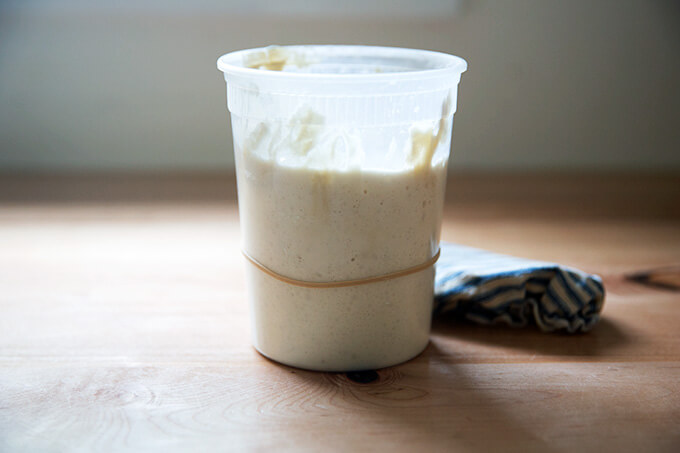
How to Feed a Sourdough Starter
In order to keep your starter alive, you have to feed it — it’s not unlike having a pet, but know this: caring for a sourdough starter is akin to caring for a very low maintenance pet, one that requires feeding only once every two to three weeks to stay alive, but one that requires feeding much more regularly if you like to bake frequently.
When I am not baking regularly, I store my starter in the fridge in the above-pictured vessel with its lid on. As noted above it can hang out there for 2-3 weeks (if not longer) without being touched. To wake it up or activate it, I like to feed it twice before using it. Often I’ll remove it from the fridge after dinner and feed it: this involves discarding most of it and replenishing it with equal parts by weight flour and water. (Please read this post, which explains in detail how to activate, feed, and maintain a starter.)
I will repeat this process in the morning — discard most of it; then replenish it with equal parts by weight flour and water. By midday, or when my starter has doubled in volume, it is ready to be used.
To store your starter, you should feed it, let it rise till it nearly doubles; then cover it and stash it in the fridge for 2 to 3 weeks until you are ready to use it again.
How Do I Know if My Starter is Ready to be Used?
If your starter doubles (or triples!) in volume within 4 to 8 hours after a feeding, it is ready to go. And ideally, you want to use your starter 4 to 8 hours after you feed it or when it has doubled. Every time I feed my starter, I place a rubber band around the vessel it is in to mark its height. This helps me see when it has doubled in volume and is, therefore, ready to be used.
If your starter is not doubling within 4 to 8 hours of feeding it, you should spend a few days strengthening it. This will involve discarding most of it — truly, don’t be afraid to be aggressive with how much you are discarding — and replenishing it with equal parts by weight flour and water. If you do this twice a day for several days, your starter will be in great shape.
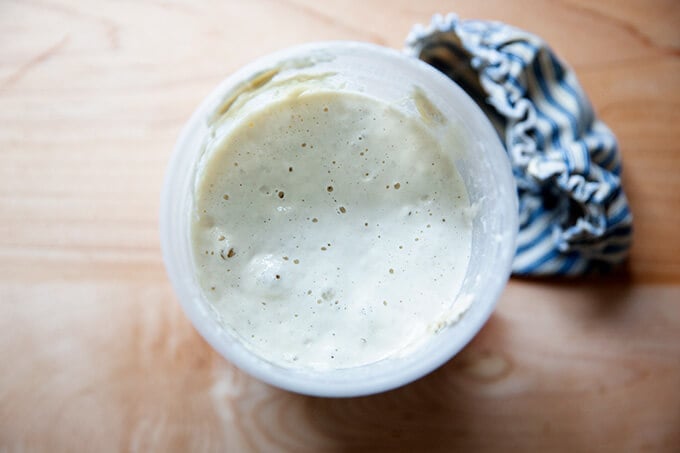
What Equipment Do I Need?
At a minimum, you’ll need:
- a sourdough starter (see above)
- flour, bread flour if possible, my preference is King Arthur Flour
- salt
- water
Ideally, you’ll also have:
- digital scale
- straight-sided vessel for monitoring the bulk fementation
- bench scraper
- flour sack towels
- parchment paper
- banneton, such as this one or this one
- razor blade
- heavy lidded vessel, such as this one or this one
How to Make Sourdough Bread: A 5-Step Overview
There are essentially 5 steps to making sourdough bread. Each of these steps is explained in more detail below.
- Mix the Dough: This is simply a matter of combining water, sourdough starter, salt and flour in bowl, and stirring to form a sticky dough ball.
- Bulk Fermentation: This is just a fancy name for the first rise. During the first two hours of the bulk fermentation, you’ll perform a series of stretches and folds, which will give the dough strength and elasticity.
- Shape + Bench Rest: This step ends the bulk fermentation. You’ll shape the dough, let it rest, then shape it once more.
- Proofing the Dough: In this recipe, you’ll cold proof the dough in the fridge, ideally for 24 to 48 hours, though you can get away with a shorter proof.
- Scoring + Baking the Dough: After the dough has proofed, you’ll turn it out onto a piece of parchment paper, score it; then transfer it to a preheated baking vessel.
How This Sourdough Bread Recipe Differs From Others
This recipe differs from others in three main ways:
- No Autolyse. Why? I’ve never found employing an autolyse makes a big difference in the final texture of the bread, and I find the process of doing an autoylse frankly to be kind of a pain. What is an autolyse? Autolyse is a technique that calls for mixing flour and water together and allowing them to sit for several hours before adding the salt and sourdough starter. This process allows gluten to develop in dough prior to mixing. It also makes the dough more extensible. This is due to the hydrating effects of soaking the flour, as well as — and this is getting a bit scientific — from the enzymatic activity of protease, which breaks down some of the gluten that forms as the dough hydrates. This process weakens the dough’s elasticity, in turn increasing its extensibility. If you are after a super open crumb, autolyse is something to consider.
- 50% (roughly) Increase in Volume. If you come from the yeast-leavened bread world, you are accustomed to letting your dough double in volume during the first rise. When I first got into sourdough, I was applying this same method, and while I had success, I realized I was often letting my dough overferment — I was pushing the bulk fermentation too far. As soon as I stopped the bulk fermentation when the dough increased by 50-75% in volume, I got a much better oven spring.
- Long Cold Proof. After the bulk fermentation, you’ll shape the dough, and store it in the fridge ideally for 24 hours but it can hang out there for 48 hours or even a bit longer. This long, cold proof will make for a much lighter, open, airy crumb. (Note: If you were to leave the dough in the fridge for 12 hours or less, which you can do, the crumb will be tighter and denser.) After you remove the dough from the fridge, you score it, and transfer it immediately to the oven — there is no need to do a room temperature proof first.
Simple Sourdough Bread: A Step-by-Step Guide
Mix the dough.
To start, pour 375 grams of water into a bowl:

Add 50 to 100 grams of sourdough starter.

Stir to combine; then add 11 grams of salt:

Finally, add 500 grams of bread flour:

Stir to combine:
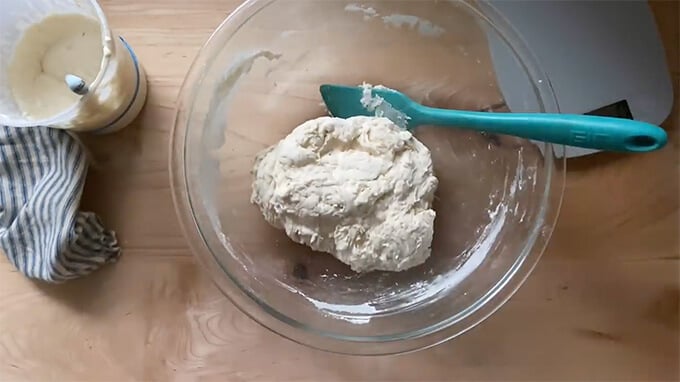
Let it Rise. (Bulk Fermentation)
Transfer the dough to a straight-sided vessel. Cover it, and let it rest for 30 minutes.

Perform a set of stretches and folds:
If time permits, perform four total sets of stretches and folds every 30 minutes for the first 2 hours. You should notice the dough getting stronger and more elastic with every set of stretches and folds. This is the 4th set:
After the 4th set of stretches and folds, cover the vessel — I love these Dot and Army cloth bowl covers for this — and set it aside until it increases in volume by 50% or so.
How long should the bulk fermentation take?
The time will vary depending primarily on the strength of your starter and the temperature of your kitchen. Rather than rely on a time period, however, you should rely on visual cues.
This video shows the dough nearly doubling (increasing by 100%) in volume, but the more I bake sourdough, the more I realize I have better success when I stop the bulk fermentation when the dough increases by 50%. It may take some trial and error to know what works best for you. You may find a 75% increase in volume is best or you may find that to be too long. Sourdough is all about experimenting and adapting based on your experiences.
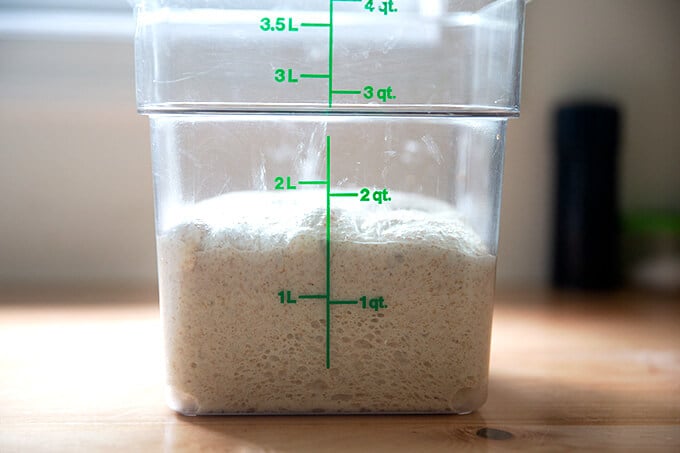
Shaping
Turn the dough out onto a lightly floured work surface:
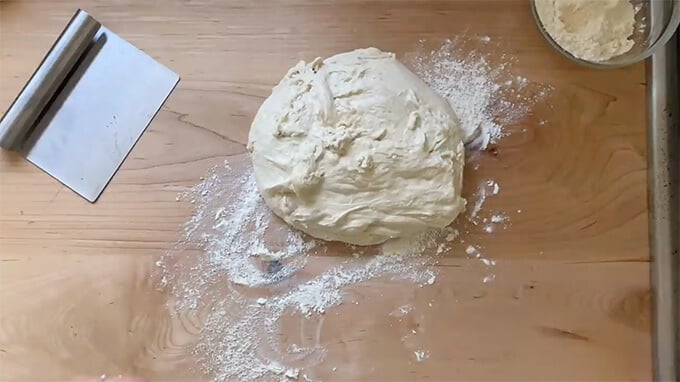
Shape the dough gently into a round and let it rest for 20-40 minutes. This is called the bench rest.
Meanwhile, prepare a bowl or banneton with a flour sack towel and rice flour.
Proofing
Shape the round again; then place in prepared bowl for proofing. Transfer to fridge for 12 to 48 hours.
Bake It.
Remove bowl from fridge, and turn it out onto a sheet of parchment paper.
Score it.

Transfer to preheated Dutch oven. Bake covered at 450ºF for 30 minutes; uncover, lower the temperature to 400ºF, and bake for 15 minutes more:

Remove from oven and let cool one hour before slicing.
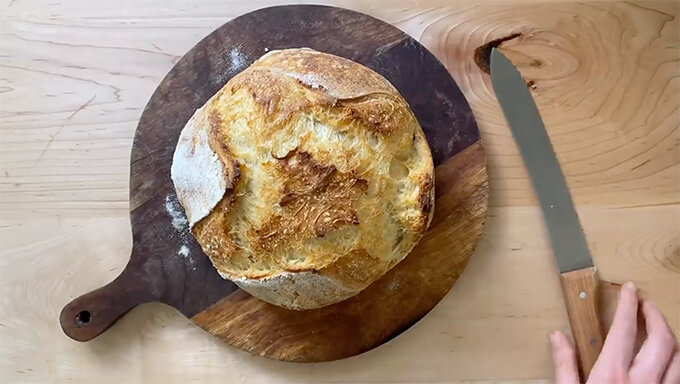
You’ll need a sharp knife (like this one or this one) when it’s time to slice:
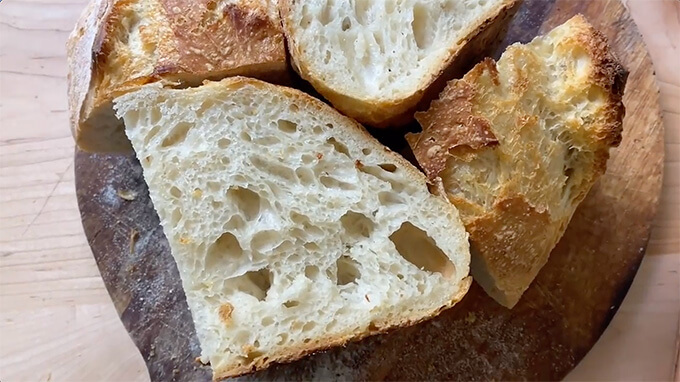

#1 Sourdough Bread Baking Tip
The refrigerator is your friend. Use it.
The most common mistake I see people make when making sourdough bread is letting the bulk fermentation go too long. They mix the dough at night; then wake up to dough that has tripled in volume and is a sticky mess.
To prevent over fermenting your dough, use your refrigerator as needed. After you complete the 4 sets of stretches and folds, you can put your dough in the fridge at any time. If you are tired and need to go to bed, transfer the dough to the refrigerator; then pick up where you left off in the morning: remove the dough from the fridge and let it continue to rise until it increases in volume by roughly 50%.
To accurately gauge when your dough has risen to roughly 50% in volume, I highly recommend investing in a straight-sided vessel such as this 4-qt Cambro (or this one, which is BPA-free!). When dough rises in a bowl, judging when it has risen sufficiently is tricky. There’s no question with a straight-sided vessel.

Troubleshooting: Where Sourdough Goes Wrong?
If you have ever had trouble baking sourdough bread, your issues likely stem from one of four places:
- Using a weak starter or not using starter at its peak.
- Using too much water relative to the flour.
- Over fermentation: letting the bulk fermentation (first rise) go too long.
- Using too much whole wheat flour, rye flour, or freshly milled flour.
I address each of these issues in this post: Why is my sourdough so sticky? 4 Common Mistakes, so please give it a read if you’ve had trouble with sourdough bread baking.
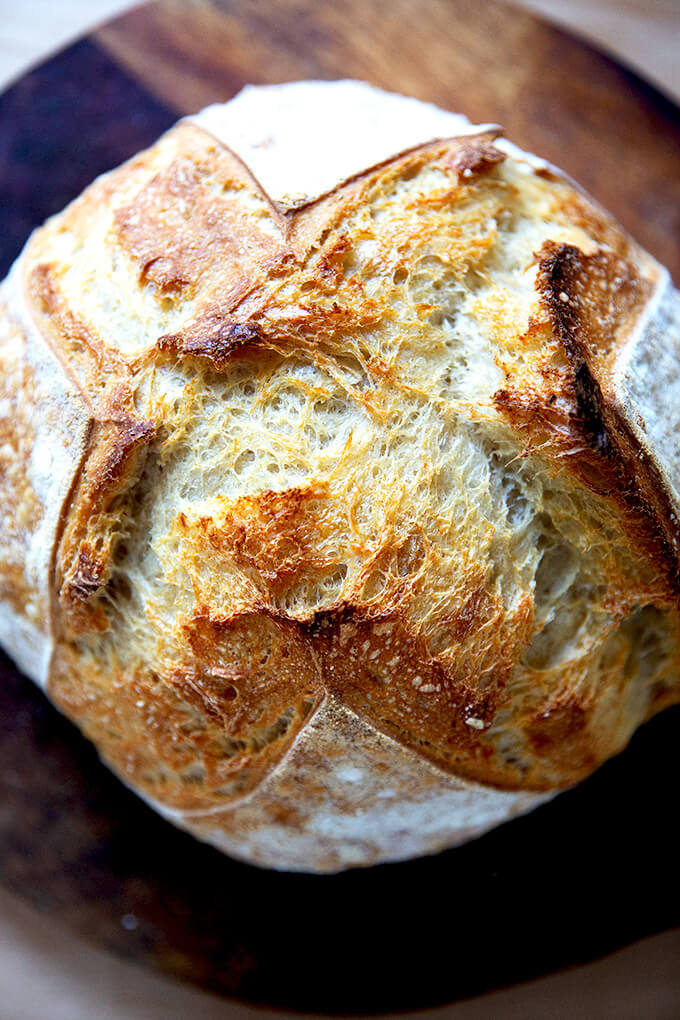
Sourdough Resources
- Sourdough Troubleshooting: This post addresses 4 common mistakes people make when baking sourdough bread and answers many FAQ’s as well.
- The Nutritional Benefits of Sourdough Bread + 6 Healthy Toast Topping Ideas
- Feeding Your Sourdough Starter
- Essential Equipment For Sourdough Bread Baking
- A tip for getting a more open crumb? Shape a batard as opposed to a round:
Other Sourdough Bread Recipes to Make
- Simple Sourdough Focaccia
- Sourdough Bread, Whole Wheat-ish
- Simple Sourdough Pizza
- Sourdough Detroit-Style Pizza
- Simple Sourdough Sandwich (or Toasting) Bread
- Sourdough Ciabatta
- Two Sourdough Discard Recipes: Sourdough Flour Tortillas & Irish Soda Bread
Sourdough Bread Baking Schedule
If you are new to sourdough bread baking, the timing of it all may feel overwhelming — you may find yourself asking: How can I do this without baking at midnight?
It’s a very good question! As noted above, your biggest friend when it comes to sourdough bread baking is your refrigerator. If after you’ve performed your stretches and folds, you don’t have time to stay up for the dough to complete the bulk fermentation, stick the vessel in the fridge and pick up where you left off the next day or the day after that.
Here is a rough schedule I like to follow. Adapt it to work for you:
Wednesday Evening: Remove starter from fridge. Feed it by discarding most of it and replenishing it with equal parts by weight flour and water.
Thursday Morning: Feed starter by discarding most of it and replenishing it with equal parts by weight flour and water.
Thursday Afternoon: Mix dough, let it rise. On Thursday evening, when the dough has completed the bulk fermentation, I’ll shape it and stick it in the fridge to proof. (As noted: If the dough hasn’t completed the bulk fermentation, I’ll stick the vessel in the fridge, and pick up where I left off the following day.)
Friday Evening or Saturday Morning: Score and Bake it. There is no need to let the dough come to room temperature before baking it. Simply remove it from the fridge, turn it out, score it, and bake it!

Homemade Sourdough Bread, Step by Step
- Total Time: 18 hours 45 minutes
- Yield: 1 loaf
Description
Inspired by The Clever Carrot
If you are new to sourdough, watch the step-by-step video here: Simple Sourdough Bread or in the post above.
Troubleshooting: If you have issues with your dough being too sticky, please read this post: Why is my sourdough so sticky? The 4 common mistakes.
Notes:
- You need an active sourdough starter. I have had success activating starters from:
- As always, I highly recommend investing in a digital scale before beginning any bread baking adventure.
- This is the Dutch Oven I use for sourdough bread. I used this Dutch oven for years, and it’s a great one, too.
- Flour sack towels are a great investment because they ensure your dough will not stick while it is proofing.
- I love using rice flour for dusting (as opposed to ap or bread flour) because it doesn’t burn. When you use a flour sack towel, however, you don’t need to use any flour.
- Find all of my sourdough essentials here: Essential Equipment For Sourdough Bread Baking
- I love a high-hydration dough, and I have great success using 380 grams of water in this recipe, so feel free to play around and push the hydration here.
- Salt: I have had success using both kosher salt and fine sea salt here. When I use kosher salt, I use the Diamond Crystal brand. When I use sea salt, I use the Baleine Fine brand. Regardless of the brand, I use 12 grams.
- Shaping: If you’re looking to get a more open crumb, try shaping a batard (as opposed to a round). Watch this video for guidance. Also: The recipe below follows the traditional shape once, rest, then shape again method. I often skip the preshape now and simply shape the dough once. I still get a nice open crumb.
How much Sourdough Starter to Use?
- Because my kitchen is cold for much of the year, I like using 100 g (1/2 cup) of starter as opposed to 50 g (1/4 cup). When determining how much starter to use, consider a few things: If you live in a warm, humid environment, 50 g should suffice. If you plan on doing an overnight rise, 50 g also should suffice. If you want to speed things up or if you live in a cold environment, consider using 100 g starter. Note: If you use 100 g of starter, your dough may rise more quickly, so keep an eye on it. As always, rely on the visual cues (increasing in volume by 50%) when determining when the bulk fermentation is done.
- A straight-sided vessel makes monitoring the bulk fermentation especially easy because it allows you to see when your dough has truly doubled.
Ingredients
- 50 – 100 g (1⁄4 – 1/2 cup) bubbly, active starter — I always use 100 grams, see notes above
- 375 g (1 1/2 cups plus 1 tbsp) warm water, or more, see notes above
- 500 g (4 cups plus 2 tbsp) bread flour
- 9 to 12 g (1.5 – 2.5 teaspoons) fine sea salt, see notes above
Instructions
- Make the dough: Whisk the starter and water together in a large bowl with a fork or spatula. Add the flour and salt. Mix to combine, finishing by hand if necessary to form a rough dough. Cover with a damp towel and let rest for 30 minutes.
- Stretch and fold: After 30 minutes, grab a corner of the dough and pull it up and into the center. Repeat until you’ve performed this series of folds 4 to 5 times with the dough. Let dough rest for another 30 minutes and repeat the stretching and folding action. If you have the time: do this twice more for a total of 4 times in 2 hours. Note: Even if you can only perform one series of stretches and folds, your dough will benefit. So don’t worry if you have to run off shortly after you mix the dough.
- Bulk Fermentation (first rise): Cover the bowl with a towel and let rise at room temperature, about 8 to 10 hours at 70°F (21°C) or even less if you live in a warm environment. The dough is ready when it has increased by 50% in volume, has a few bubbles on the surface, and jiggles when you move the bowl from side to side. (UPDATE: In the past I have recommended letting the dough rise until it doubles in volume. If you’ve had success with this, continue to let the dough double. Recently, I have been stopping the bulk fermentation when the dough increases by 50% in volume, and I feel I am actually getting better oven spring in the end.) (Note regarding timing: If you are using 100 g of starter, the bulk fermentation may take less than 8 to 10 hours. If you live in a warm, humid environment, the bulk fermentation may take even less time. In the late spring/early summer, for example, my kitchen is 78ºF and the bulk fermentation takes 6 hours. It is best to rely on visual cues (increase in volume by roughly 50%) as opposed to time to determine when the bulk fermentation is done. A straight-sided vessel makes monitoring the bulk fermentation especially easy because it allows you to see when your dough has truly increased in volume by 50%.)
- Shape (See notes above): Coax the dough onto a lightly floured surface. Gently shape it into a round: fold the top down to the center, turn the dough, fold the top down to the center, turn the dough; repeat until you’ve come full circle. If you have a bench scraper, use it to push and pull the dough to create tension.
- Rest: Let the dough rest seam side up rest for 30 minutes. Meanwhile, line an 8-inch (20-cm) bowl or proofing basket with a towel (flour sack towels are ideal) and dust with flour (preferably rice flour, which doesn’t burn the way all-purpose flour does). Using a bench scraper or your hands, shape it again as described in step 4. Place the round into your lined bowl, seam side up.
- Proof (second rise): Cover the dough and refrigerate for 1 hour or for as long as 48 hours. (Note: I prefer to let this dough proof for at least 24 hours prior to baking. See video for the difference in the crumb of a loaf that has proofed for 6 hours vs one that has proofed for 24 hours. If you choose to proof the dough in the fridge for an extended period of time, you may want to tuck it into a loosely tied bag — produce bags from the grocery store are great for this purpose — to ensure the dough does not dry out. The original recipe calls for a 1-hour rise, and if you have had success doing that, by all means, keep doing it.)
- Place a Dutch oven in your oven, and preheat your oven to 550°F (290°C). Cut a piece of parchment to fit the size of your baking pot.
- Score: Place the parchment over the dough and invert the bowl to release. Using the tip of a small knife or a razor blade, score the dough however you wish — a simple “X” is nice. Use the parchment to carefully transfer the dough into the preheated baking pot.
- Bake: Lower the oven to temperature to 450ºF (230ºC). Carefully cover the pot. Bake the dough for 30 minutes, covered. Remove the lid, lower the temperature to 400ºF (200ºC) and continue to bake for 10 – 15 minutes more. If necessary, lift the loaf out of the pot, and bake directly on the oven rack for the last 5 to 10 minutes. Cool on a wire rack for 1 hour before slicing.
- This loaf will stay fresh up to 3 days stored at room temperature in an airtight plastic bag or container. It freezes beautifully, too.
Notes
- This recipe has been adapted from Artisan Sourdough Made Simple. Changes I have made to the original recipe include:
- Using 11 g salt as opposed to 9 g.
- Performing 4 stretch and folds during the first 2 hours of the bulk fermentation, which build strength in the dough.
- Doing a cold proof for at least 24 hours before baking, which produces a lighter airier crumb. In the video, you can see the difference between the crumb of a loaf that has proofed for only 6 hours vs a loaf that has proofed for 24 hours.
- Finally, I like preheating my Dutch oven, which makes a crisper crust.
- Prep Time: 18 hours
- Cook Time: 45 minutes
- Category: Bread
- Method: Oven
- Cuisine: American
This post may contain affiliate links. Please read my disclosure policy.











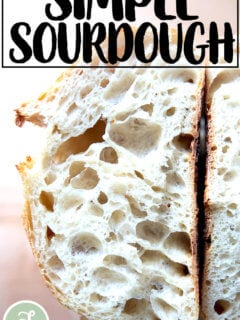
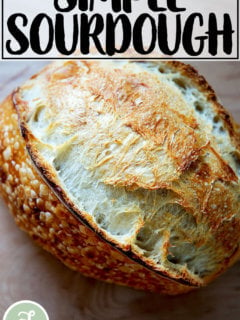
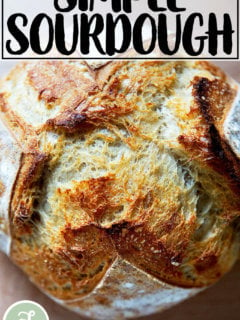

3,020 Comments on “Homemade Sourdough Bread, Step by Step”
Have used this recipe twice now, and both times my bread was amazing!
Thank you so much for this step by step guide. My family loves the bread and I am enjoying the whole bread making process. Relaxing and tasty!
So wonderful to hear this, Cat! Thanks so much for writing 🙂 🙂 🙂
is there a way to safe over proofed dough? it tripled! 🙁
Carol, it might be fine! Is it totally slack and puddly and without structure? Or does it have some strength?
It does have some structure structure. I shaped it and placed in the fridge.
Great to hear!
By the way it came out pretty good, it was a little more dense than usual but still good and great for toast. Thank you. :). Love this recipe!
Wonderful to hear, Carol! Thanks for reporting back 🙂
Oh. My. Word! I followed the recipe exactly (used 1/2 cup of starter, cold proofed for 24 hours) and it is the best bread I’ve ever had. This was my first attempt at a legit sourdough and I can’t believe how it turned out. Crisp crust, open crumb, perfect soft center – it is a wonder of a recipe. Thank you so much!
Woohoo! Wonderful to hear this, Bo 🙂 🙂 🙂 Thanks so much for writing!
Absolutely the best recipe ever! Used the 100 g of starter, and let it double in my rising room, aka my garage:) refrigerator rise, I went with the 12 hours. It came out with a good crumb, good rise, and excellent taste! All the other recipes I tried, are trash compared to this one!
Wonderful to hear this, Barb!! Thanks so much for writing. I should use my garage as well… it’s always so toasty in there.
Hi I’m looking at your sourdough recipe ( it looks fantastic) however I think in the photo sequence of the recipe you are missing the water. I can see the water in the bowl but it doesn’t say to add any. I confirmed there was water in the written recipe below because I was confused by its absence. Thought you might want to know. Once I get my hands on a starter I’ll try the bread!
Hi Amy! Thanks so much for reaching out! I hope you get your hands on some starter soon. I just checked the post, and I do see this line of text about the photo with the bowl of water in it: “To start, pour 375 grams of water into a bowl.”
Can you check again? I just want to make sure something weird isn’t going on with my site that I should look into. Thanks!
I nearly cried after making this because it came out perfect. My husband said that it looked like a professional did it. The past year and a half I have had a lot of failure, and some loafs that would pass for ok, but this was one I was SUPER proud of and is the only recipe I will be using from here forward. Thank you for sharing this. I’m one happy lady.
Awwww yay!! So great to hear this, Shannon. Happy happy baking to you!!
Iwhen I attempted bread making before, I was only making bricks for any needy construction site. love this recipe and so excited to make sourdough for my husband who loves it! Since there is only he and I at home, what temp and time schedule should I use if I split the dough in half and make 2 smaller boules?
Love this recipe- thank you for the step by step videos! Bread turned out perfect.
Great to hear, Michelle! Thanks for writing 🙂 🙂 🙂
Hi! I’m trying this recipe for the first time. Do you cover the dough with plastic when you put it in the fridge to proof, or is it ok just covered with the towel? Thanks!
Hi Grace! If you have a plastic produce bag or anything similar that you can tuck the whole bowl in, that is ideal. The towel will protect it, but I almost always now place the bowl into a produce bag and tie a knot to ensure it is protected — this is especially a good idea if you think you might stick the dough in the fridge for a few days.
Thanks for the reply! For my first attempt ever at sourdough, it came out great!! One hiccup though is that the bottom came out really burnt. Do you know what could have caused that, and what I should do next time? Thank you!
I see no one replied to your comment.. what I do is put a pizza stone on the rack under the rack holding the pot with bread. This has worked well for me as mine was also burning on the bottom.
Thanks Jeanne! I don’t have a pizza stone, but I’ll try putting a baking sheet on the lower rack next time and see that it helps.
Jeanne, thank you for jumping in here! Grace apologies for not following up! Jeanne’s idea is great and using a baking sheet should work just fine. You could also try lowering the temperatures all around: Heating the pot at 475ºF, for example, then baking covered at 425ºF, and baking uncovered at 375ºF — play around and see what works, but try the sheet pan first!
I have been using another sourdough recipe all summer, but decided to try your simple sourdough loaf recipe after trying your sourdough pizza base recipe (which was great BTW). Your simple sourdough loaf is even better! Much lighter and more airey than the recipe I was using. I proved it in the refrigerator overnight. Next time I will try 24 hours. Fab – thanks so much.
Oh yay! Wonderful to hear this, Lynda! Thanks so much for writing. I’ll be curious to hear if you’re even happier with the longer proof … report back if you feel like it but no worries if you don’t. Happy baking!
It took me months to get my sourdough starter to be active!! I tried and failed many sourdough loaves and they never worked! This was the first one that worked and turned out so beautifully I could cry!!
Such a detailed and realistic recipe!! Thanks so much!! Will be keeping this one 😌
So nice to hear this, Megan 🙂 🙂 🙂 Thanks so much for writing and sharing. Happy happy baking 🍞🍞🍞🍞🍞
I made this today and have never let dough proof for 48 hours, what an amazing loaf of bread!! This will be my ‘go to’ recipe from now on. Can’t wait to try, rosemary, garlic, seeds… the options are unlimited!!
Thanks so much
Great to hear, Sue! Thanks so much for writing 🙂 🙂 🙂
I have made so many mistakes using this recipe over the course of the year, shorted the water and tried to add more as process continued, omitted the rest before the folds, forgot the bread during bulk fermentation resulting in in dough tripled in size. All of this with almost no negative effects. It is always an attractive delicious loaf of bread we cannot wait to slice and eat. Thank you for making sourdough so accessible!!
So nice to hear this, Beverly 🙂 🙂 🙂 Thanks so much for taking the time to write.
I friend gave me a starter recently. I was intimidated by the process but stumbled upon your webpage and really glad I did. This is my first time making sourdough bread and it turned out perfect. I really couldn’t believe it. I’ve never left a comment before but had to share my success. Thank you for making the recipe easy to follow. I did have to cut down on the fermentation time since I live at 7200 ft – really glad I kept an eye on it and followed your advise about the amount of rise. Already starting a second loaf.
Wonderful to hear this, Kim! And great to hear you were able to make it work at such high elevation. Thank you for sharing your notes! So helpful for others.
Have tried a number of sour dough techniques, this was my first successful boule. I love the test to see if your starter is ready. Pure genius.
I would like to know how to crisp the bottom without really over doing it. My knife struggles when cutting it’s so “crisp”.
Great to hear, Nicole! There are a few things you can do to reduce the crispness of the bottom crust. Check out this FAQ Sourdough post for those ideas.
Hi, thank you for your guidance! How will I know if my cold-proofed dough is ready to bake? Can I just assume it will be ready to bake after at least 24 hours in the fridge? At what mark do I risk over-fermenting my dough? My fridge is pretty cold, and more or less halts fermentation altogether.
Great questions, and I don’t have a great answer, but yes: you can assume your loaf will be ready after 24 hours. Up to 48 hours is safe. After 48 hours, I’ve had mixed results. Good luck! Keep me posted on how it turns out.
Thank you for replying. Will let you know!
We made this bread with sprouted whole wheat sourdough and it worked!! We had tried before with another recipe and it ended up with a lump of coal. We had to feed it to the chickens. While the whole wheat flour didn’t yield a super pillow-y bread, it still has great flavor and is spongy and delicious. Thanks for the simple and delicious recipe!
Wonderful to hear this, Dawn! Thanks so much for writing! I love the flavor of sprouted wheat flour.
Hi Ali, your recipe is now my go to for sourdoughs thank you😊 I have 2 questions – if you wanted to add olives when would you add them in and how?
– If I’m making a big batch of dough to make 2 smaller loaves, when would you halve the dough? At the moment I do it after the bulk rise (after it reaches the 50%), before shaping and putting it into the basket for long cold retard. But I don’t know if I’m cutting out all the airiness if I halve it then?
Hi Barbs! Great to hear this and apologies for the delay here.
I would add olives at the start: toss them with the flour.
I would divide the dough into two portions after the bulk fermentation: i.e. before you transfer the shaped boules or batards to their proofing baskets/bowls.
This bread turns out perfect every time I make it! I do a mix of 25% whole wheat and 75% white.
Great to hear, Brooke! Thanks so much for writing and sharing your notes 🙂
Hi Ally
After trawling the web and looking at dozens of sourdough recipes I stumbled across your site and finally found one that works (for me at least).
But I’m still having trouble with water content.
If I use 375g water with 500g flour in the first mix – I end up with a sticky, unworkable mess. My best mix so far is to reduce water content by 50g!
Could it be the flour I’m using – a Canadian Very Strong White Wheat Flour with 14.9% protein content?
Also – you give starter content as 50g to 100g – I normally use the full 100g – what might be the effect of playing around with this quantity.
Thank you again for your wonderful site
Peter
Hi Peter! I think it must be the flour, and I think the protein content might not be the issue … I have troubleshooted with SO many people from Canada over the years, and for whatever reason, the water needs to be reduced drastically for it to work. I wonder if it’s the way the flour is milled as opposed to the protein content. Anyway, I would try reducing the water further: start with 325 grams… you can always add more water in slowly if the dough feels too stiff. I always use the 100 grams of starter as well. I would just change one variable in your next go around. Keep using the same amount of starter, but reduce the water. Hope that helps!
Hi Alexandra,
Would my bread come out ok if left in the fridge for 60 hours? I just wanted it to me warmish when I deliver it and today was the only day I could make it. I only let it rise to about 70% during the bulk fermentation.
Hi Carol, I think you could, especially since you were conservative with the bulk fermentation. I have had success leaving the dough to proof in the fridge for over 2 days, but the success of such a long proof definitely depends on the state of the dough when it enters the fridge. I think you’re good! Go for it.
I have never baked bread in my life, but decided to use your recipe with my six day old starter. I made some errors and the bread wasn’t beautiful, but it was delicious and my son and I ate every bit of it. Today my starter is several weeks old and I just took the lid off my dutch oven and lowered the oven temp. The bread is looking PERFECT! I can’t wait until it’s done and cooled off so I can try it. Thank you for an easy, straightforward recipe with videos.
So great to hear this, Jen! Thanks so much for writing. How fun to see your results improve as your starter grows and gets stronger?! Glad your son approved, too!
Great recipe!
After trying many other recipes, this one is straightforward and simple enough with the proper troubleshooting tips!
My first attempt bulk fermented too long, the second not enough but now I’m turning out AMAZING loaves of gorgeous sourdough.
Thanks!
Do you have any recipes or tips for adding spelt? Should I treat it the same as whole wheat?
Great to hear Chris! Thanks so much for writing and sharing your notes.
Regarding spelt, all spelt flours are not created equally so I can’t tell you exactly how to adjust the recipe but I can give you a few suggestions:
1. Spelt flour is known for being extensible, which you may notice during both the stretches and folds and the final shape. (Just something to note/observe.)
2. Start small: I wouldn’t use more than 100 grams to start in place of 100 grams of the bread/all purpose flour.
3. Keep the water the same this time around.
4. Take notes — if the dough feels too wet/sticky after a few sets of stretches and folds, you’ll know that you’ll need to adjust next time around with less water.
That’s all I got! Good luck.
Hi Ali your recipe looks great and I can’t wait to try it! I would like to make a jalapeno cheddar loaf, do you have any suggestions on how much cheese to add? I’m scared I’ll overdo it. TY in advance:)
Hi Ana! I would start with 1 to 1.5 cups of grated or cubed cheese. Good luck!
Sounds great, thanks for replying ☺️
Awesome recipe. Also want to note on the starter, I was in an accident and in the hospital for over two month and when I returned to home could hardly walk, so bread baking took a back seat for a decent while. After 7 month of my starter being in the refrigerator (and unfed that entire time), I wanted to see if I could revive it rather than start anew. After 3-4 days of feeding (1/2 wheat, 1/2 white outside the refrigerator) the starter came back to life.
I just used it to create a sourdough loaf using your recipe and this loaf looks, and tastes, as good as the loaves I made before (also using your recipe). Wanted to let people know that the starter is hardy so don’t give up on it. Thanks for all the guidance you provide and happy baking.
Oh my goodness, David, so nice to hear all of this but also so sorry to hear about your accident. Hope you are recovering OK. Thanks so much for taking the time to write. Starters are indeed so much hardier than we think they are. Amazing to read that you revived yours after 7 months! And great to hear your loaves are as good as ever. Again, hope you are OK and thanks for writing!
This was my first sourdough attempt and it came out great! I think I need to work on my starter a little to get that great sourdough flavor but the texture of the bread is perfect. You better bet as soon as it was out of the oven for an hour I was slicing into it to give it a try. I thought the actual process was really easy. Thanks for breaking it down and sharing.
Great to hear this, Caitlin! Waiting the hour is almost impossible. Well done! Thanks so much for writing 🙂 🙂 🙂
Started the process this morning, planning on baking Sunday morning.
In regards to a flour sack towel in your proofing basket. I have a bamboo proofing basket, rice flour (who knew, was using all purpose). Do I need to put the towel in the basket? If so I will, I don’t want the dough to stick into it either.
Looking forward to this loaf of bread!
Hi Patti! I would use the towel for the extra assurance that the dough won’t stick. I’m probably too late here at this point. What did you end up doing?
Hello. Do you go right to the oven after proofing from the fridge, or do you let the dough warm up on the counter for a bit first?
Thanks.
Right into the oven! No need to bring to room temperature.
Hi Alexandra! I made a loaf today and it looks like it turned out beautifully. I have a dough in the fridge that is going to stay in the fridge the full 48 hrs. I have a question though; I want to bring that loaf to a thanksgiving dinner would you recommend making it after the 48 hrs so it would be completed on the 23rd or should I push the time in the fridge I just want the bread to be the best. Should I make it and keep it on the counter; make it and freeze it or should I keep it in the fridge? Thanks again for the amazing recipe and instructions!!
Hi! I would suggest baking it after the 48 hours, letting it cool completely, then storing it in a ziplock bag at room temperature. On Thanksgiving day, maybe when the turkey is resting, stick the bread in the oven at 350ºF and reheat it for 15-20 minutes. Good luck and Happy Thanksgiving!
This is a great no fail recipe if you follow the directions and have a strong starter! I refer people to this recipe often!
Great to hear, Tina! Thanks for writing 🙂 🙂 🙂